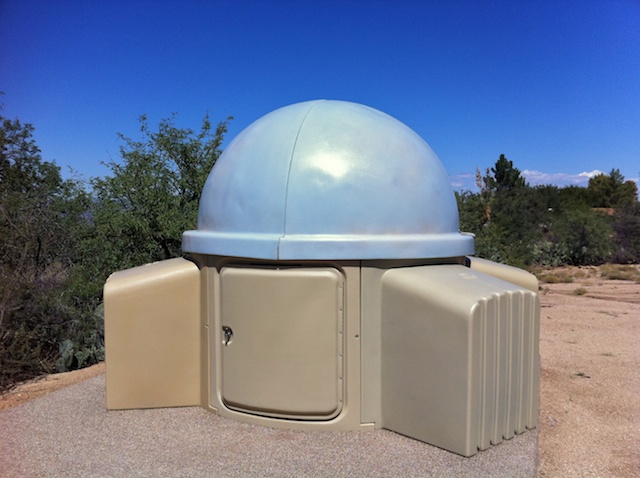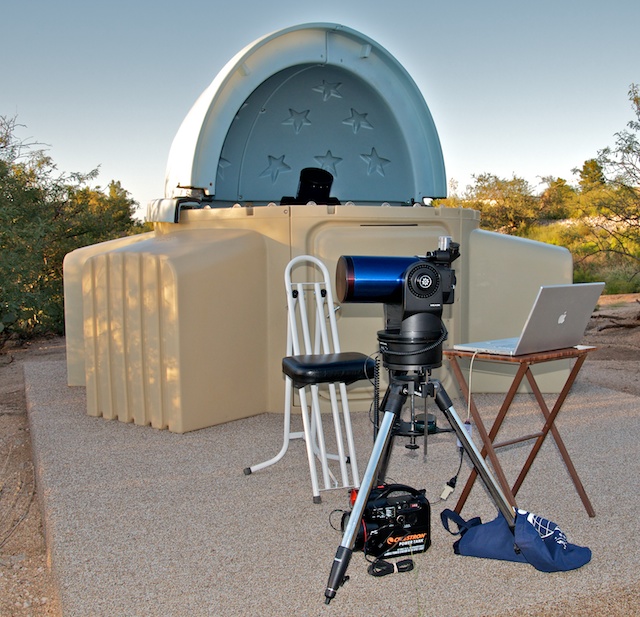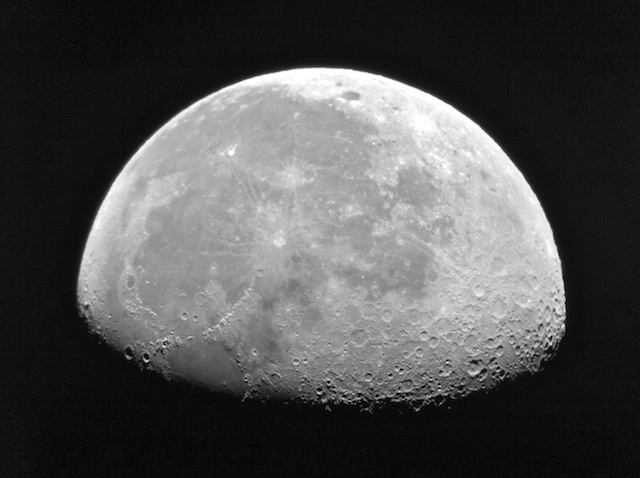
ETX and LX200 Software Testing
Posted: 18 September 2011![[Home!]](../../../../../etx/images/mighty_etx_logo_orig-sm.jpg)
 |
ETX and LX200 Software TestingPosted: 18 September 2011 |
![[Home!]](../../../../../etx/images/mighty_etx_logo_orig-sm.jpg) |
| Follow @mweasner | Welcome | Photos | Videos | Equipment | Links | Data |
Thursday, 8 September, I did a few brief "dome pulls" to pull out some of the remaining "dimples". There was one more that I had to use the ladder to reach but I saved that one for another day once I saw how the new pulls worked out. Sunday, 11 September, checked the dome again. Saturday, 10 September, we had a strong monsoon storm with lots of 1/2" hail. There was no damage from the hail. And the dimples were definitely decreasing. There was one remaining that needed some additional pulling. On Tuesday, 13 September, I checked the POD, and using a ladder to reach it, I did some more pulling on that one dimple to ensure it was completely separated from the insulation. The insulated side is almost back to the same roundness as the uninsulated side. The morning of Saturday, 17 September, I checked the dome and it is definitely looking rounder:

Compare the photo above to the ones on my "Dome Pulling" report.
Saturday, 17 September, remained clear (monsoon storm season is almost over), so after 2 weeks of cloudy nights, I opened the observatory at 1742 MST, 94°F. My main purpose for the night was to test using SkySafari for Mac OS X and AstroPlanner v2 on the MacBook Pro to control my ETX-125AT and 8" LX200-ACF telescopes. Here's the ETX setup in front of the SkyShed POD:

At 1823 MST, about 5 minutes before sunset, I viewed Venus with the 8" at 77X, low in the western sky. Its disk appeared just slightly gibbous. At 1832 MST, about 4 minutes after sunset, I viewed Saturn in the 8" at 77X. The planet and rings were just barely visible. Beginning at 1855 MST, I began my software tests with the ETX-125. At 1935 MST, I observed the supernova in the M101 galaxy with the ETX and 26mm eyepiece. The supernova was still very bright. I ended ETX tests at 2025 MST. I then began some observations with the 8" at 77X. First was the M101 supernova. Next, just for grins, I viewed the Kepler-16b host star (RA 19h 16m1 8.17s, DEC +51° 45' 26.78") that was recently in the news. I then viewed NGC6826 (the "Blinking" Planetary Nebula). I could not detect the "blinking" affect when switching from direct vieweing to averted viewing. I then tried for Sharpless 2-101 (the Tulip Nebula); I may have just barely been able to see it using an O-III filter on the 26mm eyepiece. But it was hard to be certain as the nebula was very faint. I then viewed M13 (Great Globular Cluster in Hercules), Neptune, and Uranus.
Beginning at 2120 MST, I did the software testing with the MacBook Pro connected to the 8" LX200-ACF. Ended the testing at 2200 MST and moved the ETX and computer back inside the house.
At 2242 MST, I did some observing of Jupiter at 77X, 133X, 206X, and 364X. The four Galilean Moons were visible. Seeing was not very good, but at times the views were pretty good, showing details in the cloud bands. I then slewed to the waning gibbous moon, low in the eastern sky, and did some terminator viewing at 206X and 364X. Occasionally, I would get some nice views. The south polar region was especially nice during the very brief moments of steady seeing. At 2258 MST, I set up for iPhone 4 afocal imaging with the MX-1 adapter and 26mm eyepiece. Here is a photo:

After a long day and doing some yardwork, I was getting tired and decided to call it a night. But it was great being back in the observatory, with the Milky Way glowing overhead. The observatory was closed at 2315 MST, 67°F.
I have posted an updated review of Southern Stars "SkySafari Pro for Mac OS X" discussing the telescope control. Check it out. I will be posting my review of AstroPlanner soon. I have also posted a review of the book "Astronomical Spectroscopy for Amateurs".
Go to the previous report.
Return to the Cassiopeia Observatory Welcome Page.